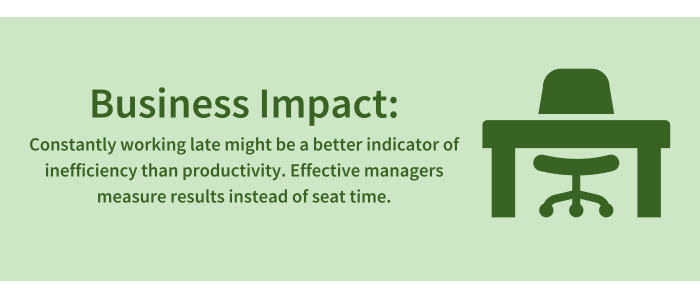Stop Measuring Employee Performance by How Long They Sit at a Desk

Is The Last Person Out of the Office Really Your Best Employee?
Hardworking, dedicated, and willingness to go the extra mile, are all things we would use to describe a great employee. But, what does that really look like in practice? Is it the employee who comes in at 7:00 AM and leaves at 7:00 PM? Is it the employee who is logging online after hours to complete projects? In actuality, those may be signs of inefficiencies and the employee’s lack of time management skills.
Managers tend to look at working longer as a sign of commitment to the organization, but would you want your employees to be hanging around not working effectively just to show their “commitment?” Working late may also be a sign of an inefficiency in the processes. When an employee fails to prioritize their work, the result may be that they need to stay back to complete their task. This can also show a sign of lack of delegation skills. If your mid-level managers are the ones “staying back,” they may not be utilizing their team to their fullest potential.
Along with a lack of efficiency, working those long hours impacts productivity as well. A Stanford study showed that after 55 hours of work per week, productivity drops so much that putting in any extra hours is working in the reverse. The study distinguished scheduled hours vs actual hours by subtracting time “lost” to sickness, absence, mealtimes, interruptions, and time spent in setting up before and after spells of production. “Lost time” through sickness was sometimes credited to the fatigue following long hours of work. Essentially, employees are getting burn out before they can even become productive workers.
No rational manager would measure a salesperson by how long they sit at a desk. They measure them by how many sales they make. So why would you measure your other employees this way? The new model of calculating productivity is measuring results rather than hours. The focus should be on what the employees have accomplished rather than the hours they log within the day. Now not every position is as easy to measure as sales, but the concept is the same. Try to measure outputs rather than inputs when gauging employee success. So how do effective managers measure “results”?
Utilizing measurables such as Key Performance Indicators (KPIs), Objectives and Key Results (OKRs), SMART Goals, Management by Objectives (MBOs), Customer Satisfaction Surveys (CSAT), and Net Promoter Score (NPS) can all be decent options if used correctly. This list might seem overwhelming, but a discussion with a qualified HR professional can help you tailor a solution that works for your specific situation.
Giving employees time within the day to take a step away from their desks, eliminating excess meetings, and sending them home on time can help ensure their productivity is maximized in the long term. If you don’t believe it, then you can keep better track of their results by properly measuring outputs instead of seat time.
Written by Gabriella Mokkas

